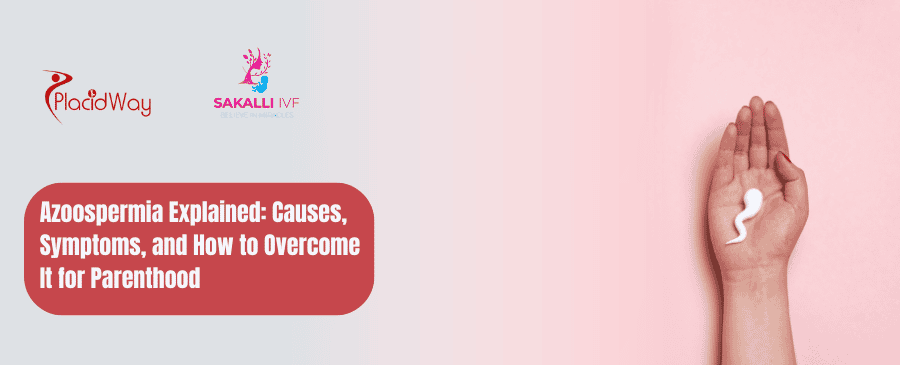
What is Azoospermia?
Azoospermia is defined as the absence of sperm in the ejaculated fluid (and in the urine after ejaculation). This condition is identified in about 10% of patients presenting with infertility.
There are three types of azoospermia:
-
Pre-testicular azoospermia (non-obstructive), resulting from the disrupted production of hormones responsible for sperm creation.
-
Testicular azoospermia (non-obstructive), stemming from any abnormality in the structure or function of the testes.
-
Post-testicular azoospermia (obstructive), resulting from issues related to ejaculation due to some kind of blockage in the reproductive system.
What Causes the Different Types of Azoospermia?
Each type of azoospermia has its own causes or associated conditions. In general, genetic conditions affecting the Y chromosome can account for 10 to 15% of cases with no or low sperm count.
1. Pre-testicular azoospermia
Pre-testicular azoospermia commonly known as secondary testicular failure, pre-testicular causes often arise from pathological endocrine conditions. This non-obstructive type can be due to certain genetic disorders. For instance, Kallmann syndrome affects the body's ability to produce the gonadotropin-releasing hormone (GnRH), which in turn affects sperm production.
Problems related to the brain, especially damage to the hypothalamus or pituitary gland, can also cause this type of azoospermia. Taking certain medications or undergoing radiation therapy for cancer can also lead to this form of azoospermia.
2. Testicular azoospermia
This non-obstructive type of azoospermia can arise from:
-
Absence of testes (anorchia)
-
Undescended testes (cryptorchidism)
-
Testes that do not produce sperm (Sertoli cell-only syndrome)
-
Testes that do not produce mature sperm (spermatogenic arrest)
Other causes include:
-
Mumps contracted in late puberty
-
Tumors
-
Radiation or chemotherapy
-
Diabetes
-
Prior surgical procedures
-
Reactions to some drugs
-
Varicocele (enlargement of the veins from the testes)
-
Use of alcohol and tobacco
3. Post-testicular azoospermia
This obstructive type is present in about 40% of azoospermia cases. There can be functional disturbances or blockages where the epididymis or vas deferens tubes that transport and store sperm are located.
Congenital diseases can also lead to blockages. For example, congenital bilateral absence of the vas deferens (CBAVD) is a genetic condition where the vas deferens channels transporting sperm from the testes might be missing. This can be associated with having or carrying genes for cystic fibrosis. Other causes of obstructive azoospermia include past or current infections, cysts, injuries, or procedures like vasectomy.
Symptoms of Azoospermia
You may not know you have azoospermia or show any symptoms until your attempts to conceive fail. Other symptoms you might encounter are more likely associated with underlying causes like hormonal imbalances or genetic chromosomal disorders.
Symptoms of azoospermia can include:
-
Reduced libido
-
Erectile dysfunction
-
Lumps, swelling, or discomfort around the testes
-
Reduced facial or body hair
How is Azoospermia Diagnosed?
The primary way to diagnose azoospermia is through a semen analysis. If there are no live sperm in the ejaculate, you might have azoospermia. You will be asked to provide a sample into a sterile container, which will then be sent to a lab for testing.
Along with a physical examination, your doctor will look into your medical history. They might ask you about:
-
Your fertility history
-
Your family history (e.g., cystic fibrosis or fertility issues)
-
Childhood diseases
-
Previous surgeries or procedures on the pelvic region or reproductive system
-
History of urinary tract infections (UTIs) or sexually transmitted infections (STIs)
-
Past or current radiation or chemotherapy treatments
-
Past or current medication usage
-
Drug or alcohol usage
-
Diseases that resulted in high fever
Other diagnostic tools may include:
-
Blood tests to check hormone levels or genetic disorders
-
Ultrasound of the scrotum and other parts of the reproductive system
-
Brain imaging methods to look for issues with the hypothalamus or pituitary gland (e.g., MRI)
-
Biopsy to inspect sperm production more closely
What are the Medical Treatments for Azoospermia?
Obstructive azoospermia can be treated by reconnecting or restructuring tubes or channels that prevent the flow of sperm. This can mean surgical procedures or other interventions.
Azoospermia caused by reduced hormone production might benefit from hormonal treatments and medications. Non-obstructive azoospermia might or might not respond to medical treatment.
Pregnancy can still be achieved through in vitro fertilization or intracytoplasmic sperm injection. Your doctor might use a small needle to extract sperm from your testes, which can also be done during a biopsy. Even if there are only a few sperm in your testes, this procedure can be effective.
The first and most important step
Receiving a diagnosis of azoospermia or hearing "no sperm count" can be daunting. Take a deep breath—it does not mean you cannot have children. The first and most important step is to understand the underlying cause. Your doctor can guide you through treatment options, including surgical correction for blockages or medical therapies to stimulate sperm production.
In cases where sperm cannot be retrieved, pregnancy is still possible through assisted reproductive techniques such as in vitro fertilization (IVF) or intracytoplasmic sperm injection (ICSI).
How and why to Contact Us?
At Sakalli IVF, we also offer sperm donation options for individuals or couples where sperm retrieval is not possible. Our expert team will support you with personalized care, comprehensive testing, and the most suitable treatment plans tailored to your needs.
If you or your partner have been diagnosed with azoospermia, don’t lose hope. Contact Sakalli IVF today to explore your options and take the next step toward building your family.




.png)
.png)

.png)
.png)

.png)
.png)





Share this listing